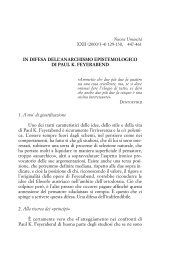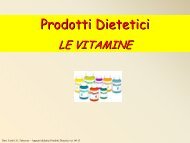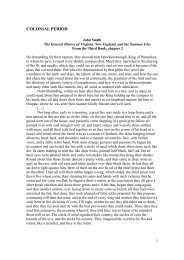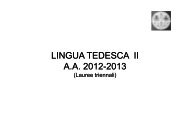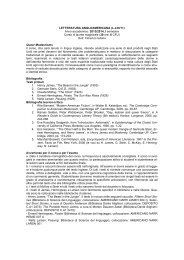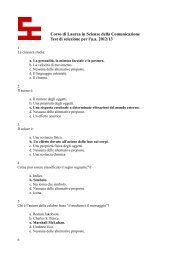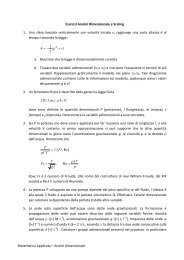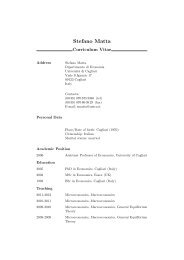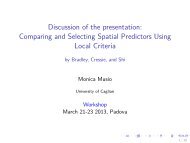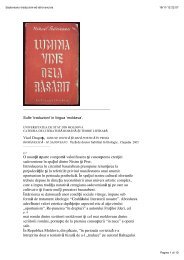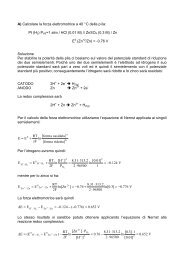steel reinforcement influence on the dynamic behaviour of ...
steel reinforcement influence on the dynamic behaviour of ...
steel reinforcement influence on the dynamic behaviour of ...
You also want an ePaper? Increase the reach of your titles
YUMPU automatically turns print PDFs into web optimized ePapers that Google loves.
STEEL REINFORCEMENT INFLUENCE ON THE DYNAMIC<br />
BEHAVIOUR OF BITUMINOUS PAVEMENT<br />
M. C<strong>on</strong>i, P.M.Bianco<br />
1 University <strong>of</strong> Cagliari, Italy<br />
2 Officine Maccaferri SpA, Italy<br />
ABSTRACT:<br />
The <strong>the</strong>oretical <strong>dynamic</strong> resp<strong>on</strong>se <strong>of</strong> a bituminous pavement was investigated under<br />
<strong>dynamic</strong> loads with harm<strong>on</strong>ic variati<strong>on</strong>. The pavement was analysed by using Finite<br />
Element Model (FEM), assuming for <strong>the</strong> materials an elastoplastic <strong>behaviour</strong>.<br />
With this study was found that <strong>the</strong> strain rate <strong>of</strong> <strong>the</strong> pavement depends <strong>on</strong> both load<br />
frequencies and damping values <strong>of</strong> bituminous c<strong>on</strong>glomerate. The results also show that<br />
high stresses are induced when <strong>the</strong> load frequency is close to <strong>the</strong> res<strong>on</strong>ance frequencies.<br />
However <strong>the</strong> higher <strong>the</strong> internal damping <strong>of</strong> <strong>the</strong> bituminous c<strong>on</strong>glomerate <strong>the</strong> lower<br />
res<strong>on</strong>ance peak is. In some case, <strong>the</strong> same effect can be obtained by using high stiff<br />
<str<strong>on</strong>g>reinforcement</str<strong>on</strong>g>, keeping c<strong>on</strong>stant damping value.<br />
Also cracks propagati<strong>on</strong> in presence <strong>of</strong> stiff <str<strong>on</strong>g>reinforcement</str<strong>on</strong>g> were investigated. The results<br />
show that <strong>the</strong> crack <strong>on</strong> reinforced paving is less width than <strong>the</strong> <strong>on</strong>e developed <strong>on</strong> <strong>the</strong><br />
same pavement designed without reinforce under <strong>the</strong> same load.<br />
The analysis was developed particularly with reference to <strong>the</strong> metallic <str<strong>on</strong>g>reinforcement</str<strong>on</strong>g><br />
Road Mesh ® , manufactured and commercialised by Officine Maccaferri Spa.<br />
1. INTRODUCTION<br />
Simplified models are usually used for designing pavements due to <strong>the</strong> high complexity<br />
and large range <strong>of</strong> variability <strong>of</strong> <strong>the</strong> parameters. These methods <strong>of</strong>ten lead to accepted<br />
overvaluati<strong>on</strong>s <strong>of</strong> <strong>the</strong> induced stresses; in many cases however static models can involve<br />
remarkable errors. In this paper we would like to show how <strong>the</strong> <strong>dynamic</strong>s <strong>of</strong> loads can<br />
produce different effects <strong>on</strong> <strong>the</strong> same paving. These effects depend <strong>on</strong> both main<br />
characteristics <strong>of</strong> <strong>the</strong> load and internal proprieties <strong>of</strong> <strong>the</strong> paving.<br />
Four different FE models for <strong>the</strong> same road paving were developed, with or without <strong>the</strong><br />
presence <strong>of</strong> an initial crack, and with or without <strong>the</strong> presence <strong>of</strong> a <str<strong>on</strong>g>steel</str<strong>on</strong>g> <str<strong>on</strong>g>reinforcement</str<strong>on</strong>g>.<br />
These models were analysed from <strong>the</strong> static and <strong>dynamic</strong> point <strong>of</strong> view. The analysis<br />
was performed using finite element program ANSYS ® [1]. Throughout <strong>the</strong> FE<br />
simulati<strong>on</strong> <strong>the</strong> effect <strong>of</strong> <strong>the</strong> <str<strong>on</strong>g>reinforcement</str<strong>on</strong>g> <strong>on</strong> <strong>the</strong> internal stress-strength distributi<strong>on</strong> and<br />
<strong>on</strong> cracks propagati<strong>on</strong>, were investigated.<br />
The Road Mesh ® product was used as <str<strong>on</strong>g>reinforcement</str<strong>on</strong>g> for <strong>the</strong> pavement. The Road<br />
Mesh® is a <str<strong>on</strong>g>steel</str<strong>on</strong>g> <str<strong>on</strong>g>reinforcement</str<strong>on</strong>g> well known <strong>on</strong> <strong>the</strong> Italian and European Market.<br />
It c<strong>on</strong>sists <strong>of</strong> a double twisted <str<strong>on</strong>g>steel</str<strong>on</strong>g> wire mesh with stiffening transversal <str<strong>on</strong>g>steel</str<strong>on</strong>g> bars. The<br />
<str<strong>on</strong>g>reinforcement</str<strong>on</strong>g> is manufactured and sold by Officine Maccaferri Spa.<br />
M. CONI – P.M.Bianco, Steel Reinforcement Influence, Page 2 di 10<br />
Fax : (39)-070-6755266 email: mc<strong>on</strong>i@unica.it<br />
Cagliari, 19.11.1999
2. MODEL DESCRIPTION<br />
A flexible pavement, comm<strong>on</strong>ly used for designing roads with ordinary loads, was<br />
studied and analysed.<br />
The Fig. n° 1 shows <strong>the</strong> thickness and some characteristics <strong>of</strong> layers <strong>of</strong> pavement.<br />
Fig. 1 Fig. 2<br />
A 3-dimensi<strong>on</strong>al model was assumed for <strong>the</strong> numerical simulati<strong>on</strong>. The dimensi<strong>on</strong>s <strong>of</strong><br />
<strong>the</strong> modelled porti<strong>on</strong> are 0.96 m x 0.96 x 0.77 m. The dimensi<strong>on</strong> were chosen according<br />
to <strong>the</strong> results obtained during static analysis. In fact, it was found that when <strong>the</strong> area <strong>of</strong><br />
<strong>the</strong> model was bigger than 0.85x0.85 m, <strong>the</strong> rate <strong>of</strong> displacement <strong>on</strong> <strong>the</strong> pavement was<br />
slightly <str<strong>on</strong>g>influence</str<strong>on</strong>g>d by changing its dimensi<strong>on</strong>. As boundary c<strong>on</strong>diti<strong>on</strong>s were assumed<br />
lateral displacements equal to zero to simulate <strong>the</strong> c<strong>on</strong>diti<strong>on</strong>s <strong>of</strong> <strong>the</strong> real model. The<br />
model was designed with a depth <strong>of</strong> 0.77 m ignoring <strong>the</strong> lower layers because <strong>the</strong>ir<br />
c<strong>on</strong>tributes were negligible. Fig. 2 shows <strong>the</strong> modelled geometry. BRICK elements<br />
were used, assuming an elastoplastic <strong>behaviour</strong> for materials [1]. The damping value ξ<br />
<strong>of</strong> bituminous c<strong>on</strong>glomerate were increased to simulate energy dissipati<strong>on</strong>, actually<br />
caused by viscous <strong>behaviour</strong> <strong>of</strong> <strong>the</strong> material.<br />
Tab. n° 1 shows <strong>the</strong> main values <strong>of</strong> <strong>the</strong> adopted geomechanical parameters <strong>of</strong> <strong>the</strong><br />
different materials.<br />
Layer Thickness Modulus Coefficient Spec. Weight<br />
[cm] [GPa] Poiss<strong>on</strong> Kg/m 3<br />
Fricti<strong>on</strong> Cohesi<strong>on</strong><br />
angle MPa<br />
Wearing course 3 2.7 0.47 1700 43° 0.5<br />
Base course 4 2.7 0.47 1600 43° 0.5<br />
Road base 10 1.6 0.45 1500 45° 0.35<br />
Foundati<strong>on</strong> 20 0.2 0.35 1400 47° 0.01<br />
Subgrade 40 0.1 0.30 1300 30° 0.025<br />
Tab.1: materials characterisati<strong>on</strong><br />
M. CONI – P.M.Bianco, Steel Reinforcement Influence, Page 2 di 10<br />
Fax : (39)-070-6755266 email: mc<strong>on</strong>i@unica.it<br />
Cagliari, 19.11.1999
A vertical static load <strong>of</strong> 40 kN was applied <strong>on</strong> a circular area <strong>of</strong> radius 0.16 m. In this<br />
case, <strong>the</strong> pavement superstructure leads to high stress levels, very close to <strong>the</strong> plastic<br />
field but without to reach it in any case. This c<strong>on</strong>diti<strong>on</strong> allows to put into evidence some<br />
characteristics <strong>of</strong> <strong>the</strong> structural <strong>behaviour</strong> <strong>of</strong> <strong>the</strong> bituminous pavements. For <strong>the</strong> modal<br />
<strong>dynamic</strong> analysis, <strong>the</strong> load positi<strong>on</strong> is outlying to obtain, all <strong>the</strong> vibrati<strong>on</strong> mode shape. In<br />
fact, a centred load is not able to start up any vibrati<strong>on</strong>s made shapes when applied in a<br />
node area, as for example <strong>the</strong> central area <strong>of</strong> <strong>the</strong> modelled structure.<br />
The <str<strong>on</strong>g>steel</str<strong>on</strong>g> <str<strong>on</strong>g>reinforcement</str<strong>on</strong>g> was simulated by BEAM elements[1], assuming <strong>the</strong> <strong>behaviour</strong><br />
<strong>of</strong> <strong>the</strong> material as linear elastic. However, <strong>the</strong> <strong>behaviour</strong> <strong>of</strong> bituminous c<strong>on</strong>crete was<br />
simulated by using a perfect elasto-plastic model (Drucker-Prager) [8].<br />
Fig.3<br />
Fig. n° 3 shows <strong>the</strong> four c<strong>on</strong>sidered geometries: <strong>the</strong> Model A represents a typical<br />
pavement; in <strong>the</strong> Model B <strong>the</strong> <str<strong>on</strong>g>steel</str<strong>on</strong>g> <str<strong>on</strong>g>reinforcement</str<strong>on</strong>g> has been inserted; <strong>the</strong> Models C and<br />
D, which are respectively similar to Models A and B, have a crack under <strong>the</strong> load. The<br />
crack was modelled not allowing <strong>the</strong> c<strong>on</strong>tact between two parts <strong>of</strong> <strong>the</strong> pavement under<br />
<strong>the</strong> applied load. The distance between <strong>the</strong> two parts was 1 mm. Then, during <strong>the</strong><br />
analysis <strong>the</strong> displacements were calculated to evaluate <strong>the</strong> opening <strong>of</strong> <strong>the</strong> crack [3].<br />
M. CONI – P.M.Bianco, Steel Reinforcement Influence, Page 2 di 10<br />
Fax : (39)-070-6755266 email: mc<strong>on</strong>i@unica.it<br />
Cagliari, 19.11.1999
Several analysis have been carried out for different values <strong>of</strong> bituminous c<strong>on</strong>crete<br />
damping. Different positi<strong>on</strong>s <strong>of</strong> <strong>the</strong> <str<strong>on</strong>g>reinforcement</str<strong>on</strong>g> have been analysed too ( +2, +4, +6, +<br />
8 cm from <strong>the</strong> foundati<strong>on</strong> interface layer).<br />
3. ANALYTICAL<br />
The system is governed by <strong>the</strong> expressi<strong>on</strong> [ M ]{ u&<br />
} + [ C]{<br />
u&<br />
} + [ K]{<br />
u}<br />
= { F}<br />
& , where:<br />
[M] = structure mass matrix { u } = nodal displacement vector<br />
[C] = structure damping matrix { u& } = nodal velocity vector<br />
[K] = structure stiffness matrix { u& & } = nodal accelerati<strong>on</strong> vector<br />
[F] = time-dependent forcing functi<strong>on</strong><br />
The complete expressi<strong>on</strong> for <strong>the</strong> structure damping matrix , [C], is <strong>the</strong> following:<br />
Nmat<br />
[ C ] = α [ M ] + β [ K ] + ∑ β j [ K j ] + [ C ξ ] + ∑<br />
j = 1<br />
K = 1<br />
M. CONI – P.M.Bianco, Steel Reinforcement Influence, Page 2 di 10<br />
Fax : (39)-070-6755266 email: mc<strong>on</strong>i@unica.it<br />
Cagliari, 19.11.1999<br />
Nel<br />
[ C ]<br />
Damping can be specified by any or all <strong>of</strong> <strong>the</strong> following methods: mass damping α;<br />
structural damping (c<strong>on</strong>stant β, material dependent βi); c<strong>on</strong>stant equivalent viscous<br />
damping ratio ξ; discrete element damping.<br />
In this paper, structural damping was included. This allowed models to run with a<br />
different damping value, βi, in each layer <strong>of</strong> <strong>the</strong> superstructures. Structural damping<br />
depends <strong>on</strong> <strong>the</strong> natural frequency: ξi<br />
ξi<br />
β i = =<br />
ωi<br />
πfi<br />
2 where ωi = 2πfi and fi is <strong>the</strong><br />
frequency <strong>of</strong> mode i.<br />
Modal analysis is used to determine <strong>the</strong> natural frequency and mode shapes <strong>of</strong> a<br />
structure. Free, undamped vibrati<strong>on</strong>s are assumed in ANSYS (F(t)={0} and [C]= 0). A<br />
modal analysis should precede any o<strong>the</strong>r <strong>dynamic</strong> analysis. The governing equati<strong>on</strong> <strong>the</strong>n<br />
M u&<br />
& + K u = 0 . For a linear system, free vibrati<strong>on</strong> will be a harm<strong>on</strong>ic <strong>of</strong> <strong>the</strong><br />
is: [ ]{} [ ]{} {}<br />
form, { u} = { u } cosωt<br />
. For <strong>the</strong> n<strong>on</strong>-trivial soluti<strong>on</strong>, <strong>the</strong> determinant [ ] −<br />
2[<br />
M ] = 0<br />
0<br />
K ω .<br />
This is an eigenvalue problem, whose soluti<strong>on</strong> are <strong>the</strong> eigenvalues and <strong>the</strong> corresp<strong>on</strong>ding<br />
eigenvectors. The eigenvalues represent <strong>the</strong> natural frequency <strong>of</strong> <strong>the</strong> system and <strong>the</strong><br />
eigenvectors <strong>the</strong> corresp<strong>on</strong>ding mode shapes. Harm<strong>on</strong>ic analysis is used to determine <strong>the</strong><br />
resp<strong>on</strong>se <strong>of</strong> a structure to harm<strong>on</strong>ic sinusoidally varying forces. The functi<strong>on</strong> F(t) is a<br />
periodic value <strong>of</strong> known amplitude and frequency. The equati<strong>on</strong> <strong>of</strong> moti<strong>on</strong>, <strong>the</strong>refore,<br />
can be solved to obtain displacements such as functi<strong>on</strong> <strong>of</strong> frequency. The equilibrium<br />
M u&<br />
& + C u&<br />
+ K u = F (t)<br />
equati<strong>on</strong> will now be: [ ]{} [ ]{ } [ ]{ } { }<br />
4. RESULTS<br />
The <strong>dynamic</strong> characteristic <strong>of</strong> loads has a great incidence <strong>on</strong> <strong>the</strong> structural <strong>behaviour</strong> <strong>of</strong><br />
pavements. Previous researches have dem<strong>on</strong>strated that <strong>the</strong>re is a direct proporti<strong>on</strong><br />
relati<strong>on</strong>ship between load and strain by approaching pavement design through static<br />
models [6]. Before starting <strong>the</strong> <strong>dynamic</strong> analysis <strong>the</strong> static <strong>behaviour</strong> was studied; <strong>the</strong><br />
k
esults show a reducti<strong>on</strong> <strong>of</strong> vertical deflecti<strong>on</strong> under <strong>the</strong> load (see Fig. n° 4, 5). The<br />
tensile stresses in <strong>the</strong> road base and <strong>the</strong> foundati<strong>on</strong> layer are ra<strong>the</strong>r reduced.<br />
The <str<strong>on</strong>g>steel</str<strong>on</strong>g> <str<strong>on</strong>g>reinforcement</str<strong>on</strong>g> has not any <str<strong>on</strong>g>influence</str<strong>on</strong>g> <strong>on</strong> vertical compressive stress comp<strong>on</strong>ent.<br />
Fig. 4 Fig.5<br />
Fig. n° 6 and 7 show that <strong>the</strong> vertical positi<strong>on</strong> <strong>of</strong> <strong>the</strong> <str<strong>on</strong>g>reinforcement</str<strong>on</strong>g> has not a big<br />
<str<strong>on</strong>g>influence</str<strong>on</strong>g> <strong>on</strong> <strong>the</strong> stress level into <strong>the</strong> bituminous c<strong>on</strong>crete.<br />
Fig. 6 Fig. 7<br />
When cracks are present, vertical deflecti<strong>on</strong>s increase in <strong>the</strong> same way, independently<br />
from <strong>the</strong> presence <strong>of</strong> <strong>the</strong> <str<strong>on</strong>g>reinforcement</str<strong>on</strong>g>, instead <strong>of</strong> <strong>the</strong> crack opening, when <strong>the</strong><br />
<str<strong>on</strong>g>reinforcement</str<strong>on</strong>g> is present, is ra<strong>the</strong>r reduced ( Fig. n° 8 and 9).<br />
M. CONI – P.M.Bianco, Steel Reinforcement Influence, Page 2 di 10<br />
Fax : (39)-070-6755266 email: mc<strong>on</strong>i@unica.it<br />
Cagliari, 19.11.1999
Fig. 8 Fig. 9<br />
Plasticized z<strong>on</strong>es come out by increasing vertical load in <strong>the</strong> foundati<strong>on</strong> layer and in <strong>the</strong><br />
base course. In plastic c<strong>on</strong>diti<strong>on</strong> Uy and σx (Vertical displacement and horiz<strong>on</strong>tal stress<br />
respectively) <strong>of</strong> <strong>the</strong> two structures ( reinforced and unreinforced) get close to each o<strong>the</strong>r .<br />
The <strong>behaviour</strong> is different when cracks are already present in <strong>the</strong> pavements. In fact, in<br />
this case, even in plastic c<strong>on</strong>diti<strong>on</strong>s cracks opening <strong>of</strong> <strong>the</strong> reinforced structure are smaller.<br />
Fig. n° 10, 11 show <strong>the</strong> two different deflecti<strong>on</strong>s <strong>of</strong> A and B Models; for <strong>the</strong> reinforced<br />
model, a smaller porti<strong>on</strong> <strong>of</strong> <strong>the</strong> structure is interested by vertical displacement.<br />
Fig. 10 Fig. 11<br />
The <strong>dynamic</strong> approach shows that <strong>the</strong> relati<strong>on</strong>ship between stress-strain and load<br />
intensity is not proporti<strong>on</strong>al; even <strong>the</strong> load frequency <str<strong>on</strong>g>influence</str<strong>on</strong>g>s <strong>the</strong> stress strain<br />
distributi<strong>on</strong>. With <strong>dynamic</strong> loads, vertical deflecti<strong>on</strong> is amplified when <strong>the</strong> load<br />
frequency is close to <strong>the</strong> res<strong>on</strong>ance frequencies <strong>of</strong> <strong>the</strong> structure. The following Fig.<br />
n°12,13,14 and 15 show some modal shapes.<br />
Fig. 12: 9.1499 Hz Fig. 13: 10.503 Hz<br />
M. CONI – P.M.Bianco, Steel Reinforcement Influence, Page 2 di 10<br />
Fax : (39)-070-6755266 email: mc<strong>on</strong>i@unica.it<br />
Cagliari, 19.11.1999
The obtained first Fig. res<strong>on</strong>ance 14: 21.595 frequency Hz <strong>of</strong> <strong>the</strong> analysed model Fig. is 15: close 24.258 to 10 Hz<br />
Hz. By <strong>the</strong><br />
increasing <strong>of</strong> <strong>the</strong> geometry dimensi<strong>on</strong>s <strong>of</strong> <strong>the</strong> model, generally, res<strong>on</strong>ance frequencies<br />
are reduced; <strong>the</strong> higher frequencies are more reduced than <strong>the</strong> lower <strong>on</strong>es. On <strong>the</strong><br />
c<strong>on</strong>trary, <strong>the</strong> stiffness <strong>of</strong> <strong>the</strong> materials produces increase <strong>of</strong> <strong>the</strong> res<strong>on</strong>ance frequencies.<br />
The <str<strong>on</strong>g>steel</str<strong>on</strong>g> <str<strong>on</strong>g>reinforcement</str<strong>on</strong>g>, as it has a stiffening effect <strong>on</strong> <strong>the</strong> pavement, produces an<br />
increase <strong>of</strong> <strong>the</strong> pavement res<strong>on</strong>ance frequencies. It is important to notice that <strong>the</strong><br />
corresp<strong>on</strong>dent frequency <strong>of</strong> loads applied by heavy vehicles is <strong>of</strong>ten close to <strong>the</strong><br />
res<strong>on</strong>ance frequency <strong>of</strong> <strong>the</strong> pavement.<br />
The bottom layers <strong>of</strong> a pavement are generally elastically stressed, later than <strong>the</strong> upper<br />
layers due to <strong>the</strong> damping <strong>of</strong> <strong>the</strong> bituminous c<strong>on</strong>crete. This might be put into evidence<br />
with a modal analysis, characterising <strong>the</strong> materials with a certain damping..<br />
Fig. 16<br />
As already shown for <strong>the</strong> static approach <strong>the</strong> <str<strong>on</strong>g>reinforcement</str<strong>on</strong>g> reduces <strong>the</strong> stress and strain<br />
level; this reducti<strong>on</strong> becomes remarkable close to <strong>the</strong> res<strong>on</strong>ance frequency for which<br />
generally stress and strain level is very high. It is very important to put into evidence <strong>the</strong><br />
following outcome: <strong>the</strong> relati<strong>on</strong>ship between stress and strain and load frequency is<br />
almost independent from damping, when <strong>the</strong> <str<strong>on</strong>g>reinforcement</str<strong>on</strong>g> is present.<br />
M. CONI – P.M.Bianco, Steel Reinforcement Influence, Page 2 di 10<br />
Fax : (39)-070-6755266 email: mc<strong>on</strong>i@unica.it<br />
Cagliari, 19.11.1999
Fig. 17 Fig. 18<br />
The curves in Fig. n°18 give <strong>the</strong> vertical deflecti<strong>on</strong>, “normalized” by <strong>the</strong> static<br />
deflecti<strong>on</strong>, versus <strong>the</strong> load frequencies. These curves refer to <strong>the</strong> Model C and D, that is<br />
unreinforced and reinforced with <strong>the</strong> presence <strong>of</strong> start cracks. Three different<br />
percentages <strong>of</strong> damping have been taken into account (ξ = 2%, 4% e 6%). It is well<br />
evident that <strong>the</strong> same load in terms <strong>of</strong> intensity may produce different stresses in<br />
relati<strong>on</strong> to <strong>the</strong> ratio between its frequency and res<strong>on</strong>ance frequencies <strong>of</strong> <strong>the</strong> structure.<br />
The stress level may be lower or higher than <strong>the</strong> <strong>on</strong>e induced by <strong>the</strong> static load. The Fig.<br />
n° 17 shows <strong>the</strong> same comparis<strong>on</strong> with reference to plain stress in to <strong>the</strong> road base, close<br />
to <strong>the</strong> foundati<strong>on</strong> layer.<br />
Fur<strong>the</strong>r simulati<strong>on</strong>s have been carried<br />
out to evaluate <strong>the</strong> growing <strong>of</strong> <strong>the</strong> crack<br />
opening versus load frequencies. The<br />
crack opening was calculated The results<br />
are shown in Fig. n° 19.<br />
OPENING CRACK<br />
Fig. 19<br />
Some frequencies are particularly damaging for <strong>the</strong> analysed model. These frequencies<br />
are close to 24 Hz , that is close to <strong>the</strong> 5 th and 6 th res<strong>on</strong>ance frequency. Ra<strong>the</strong>r different<br />
is <strong>the</strong> <strong>behaviour</strong> <strong>of</strong> Models C and D for <strong>the</strong>se values <strong>of</strong> load frequencies. For <strong>the</strong> Model<br />
M. CONI – P.M.Bianco, Steel Reinforcement Influence, Page 2 di 10<br />
Fax : (39)-070-6755266 email: mc<strong>on</strong>i@unica.it<br />
Cagliari, 19.11.1999
C <strong>the</strong> crack opening increases quickly, until <strong>the</strong> surface is reached. For <strong>the</strong> Model D <strong>the</strong><br />
presence <strong>of</strong> <strong>the</strong> <str<strong>on</strong>g>reinforcement</str<strong>on</strong>g> reduces <strong>the</strong> growing <strong>of</strong> <strong>the</strong> cracks, preventing that <strong>the</strong><br />
cracks get to <strong>the</strong> surface. It is important to underline that for <strong>the</strong> unreinforced Model<br />
even increasing <strong>the</strong> material damping , it is not possible to obtain <strong>the</strong> same result. It is<br />
evident that this different <strong>behaviour</strong> may <str<strong>on</strong>g>influence</str<strong>on</strong>g> <strong>the</strong> pavement life. In order to better<br />
show <strong>the</strong>se differences Fig. n° 20 has been prepared.<br />
Fig. 20<br />
For each frequency it is represented both <strong>the</strong> curve <strong>of</strong> <strong>the</strong> reinforced model and <strong>the</strong> curve<br />
<strong>of</strong> <strong>the</strong> unreinforced <strong>on</strong>e. For every load frequency value <strong>the</strong> <str<strong>on</strong>g>steel</str<strong>on</strong>g> <str<strong>on</strong>g>reinforcement</str<strong>on</strong>g> involves<br />
smaller increase <strong>of</strong> <strong>the</strong> cracks.<br />
CONCLUSIONS<br />
A FE model <strong>of</strong> a flexible road superstructures, with and without <strong>the</strong> <str<strong>on</strong>g>steel</str<strong>on</strong>g> reinforced<br />
Road Mesh ® , was developed in order to understand its <strong>dynamic</strong> <strong>behaviour</strong> and its modal<br />
damping characteristics. Static, modal and harm<strong>on</strong>ic analyses were performed and result<br />
extracted. Parameter studies were also carried out, with various reinforced positi<strong>on</strong> and<br />
with various viscous damping ratios <strong>of</strong> <strong>the</strong> bituminous c<strong>on</strong>crete.<br />
The aim was to put in evidence how <strong>the</strong> stress strain level depends <strong>on</strong> <strong>the</strong> <strong>dynamic</strong><br />
characteristics <strong>of</strong> <strong>the</strong> load and from <strong>the</strong> geomechanical characteristics <strong>of</strong> <strong>the</strong> material <strong>of</strong><br />
<strong>the</strong> pavings.<br />
Fur<strong>the</strong>rmore, it has been underlined that <strong>the</strong> Road Mesh <str<strong>on</strong>g>reinforcement</str<strong>on</strong>g>, thanks to its high<br />
stiffness, can <str<strong>on</strong>g>influence</str<strong>on</strong>g> <strong>the</strong> <strong>behaviour</strong> <strong>of</strong> <strong>the</strong> whole structure.<br />
M. CONI – P.M.Bianco, Steel Reinforcement Influence, Page 2 di 10<br />
Fax : (39)-070-6755266 email: mc<strong>on</strong>i@unica.it<br />
Cagliari, 19.11.1999
Close to <strong>the</strong> res<strong>on</strong>ance frequencies, that is when high strain are induced, <strong>the</strong><br />
<str<strong>on</strong>g>reinforcement</str<strong>on</strong>g> has an equivalent damping effect which is much bigger than <strong>the</strong> damping<br />
which may be normally present in <strong>the</strong> bituminous c<strong>on</strong>crete. It is even more interesting,<br />
<strong>the</strong> outcome in presence <strong>of</strong> existing cracks.<br />
The c<strong>on</strong>sidered <str<strong>on</strong>g>reinforcement</str<strong>on</strong>g> is able to oppose <strong>the</strong> growing <strong>of</strong> cracks, that is <strong>the</strong><br />
reflecti<strong>on</strong> towards <strong>the</strong> surface.<br />
This performance has a big <str<strong>on</strong>g>influence</str<strong>on</strong>g> <strong>on</strong> <strong>the</strong> paving life, having as a c<strong>on</strong>sequence a<br />
remarkable increase <strong>of</strong> it. Fur<strong>the</strong>r researches will be performed to assess <strong>the</strong> <strong>behaviour</strong><br />
<strong>of</strong> o<strong>the</strong>r type <strong>of</strong> <str<strong>on</strong>g>reinforcement</str<strong>on</strong>g>.<br />
REFERENCES<br />
[1]ANSYS User’s Manual, Revisi<strong>on</strong> 55, Volume IV: Theory. Swans<strong>on</strong> Analysis<br />
Systems Inc.<br />
[2] M.Losa, “Influenza delle membrane geotessili sulle prestazi<strong>on</strong>i delle sovrastrutture<br />
stradali”, Atti del C<strong>on</strong>vegno “I Materiali nella Sovrastruttura Stradale” Società<br />
Italiana Infrastrutture Viarie SIIV, Anc<strong>on</strong>a 14-16 ottobre 1996.<br />
[3] A.Scarpas, A.H. De B<strong>on</strong>dt, A.A.A. Molenaar, G. Gaarkeuken, ”Finite elements<br />
modelling <strong>of</strong> craking in pavements”, Third Internati<strong>on</strong>al RILEM C<strong>on</strong>ference,<br />
Maastricht, Ne<strong>the</strong>rlands, 2-4 October 1996.<br />
[4] A.H. De B<strong>on</strong>dt, A.Scarpas, M.P. Steenvoorden, ”Effects <strong>of</strong> reiforcement <strong>on</strong> crak<br />
resp<strong>on</strong>se”, Third Internati<strong>on</strong>al RILEM C<strong>on</strong>ference, Maastricht, Ne<strong>the</strong>rlands, 2-4<br />
October 1996.<br />
[5] A.Scarpas, A.H. De B<strong>on</strong>dt, G. Gaarkeuken, ”Reflective craking c<strong>on</strong>trol via<br />
reinforcing system: FE modelling <strong>of</strong> craking in pavements”, Third Internati<strong>on</strong>al<br />
RILEM C<strong>on</strong>ference, Maastricht, Ne<strong>the</strong>rlands, 2-4 October 1996.<br />
[6] O.Luc<strong>on</strong>i, M.C<strong>on</strong>i, F.Annunziata, “Analisi Teorico Sperimentale Di Sovrastrutture<br />
Rinforzate”, Atti della Facoltà di Ingegneria dell’Università degli Studi di Cagliari,<br />
vol.39, ottobre 1995.<br />
[7] G.D<strong>on</strong>di, “Modellazi<strong>on</strong>e del macro rinforzo di sovrastrutture stradali flessibili”, Atti<br />
del XXII C<strong>on</strong>vegno Nazi<strong>on</strong>ale Stradale, pagg. 1- 10 sez. IV, Perugia 26 giugno - 2<br />
luglio 1994.<br />
[8]ANSYS User’s Manual, Revisi<strong>on</strong> 55, Volume IV: Theory, 4.18. Swans<strong>on</strong> Analysis<br />
Systems Inc.<br />
M. CONI – P.M.Bianco, Steel Reinforcement Influence, Page 2 di 10<br />
Fax : (39)-070-6755266 email: mc<strong>on</strong>i@unica.it<br />
Cagliari, 19.11.1999



